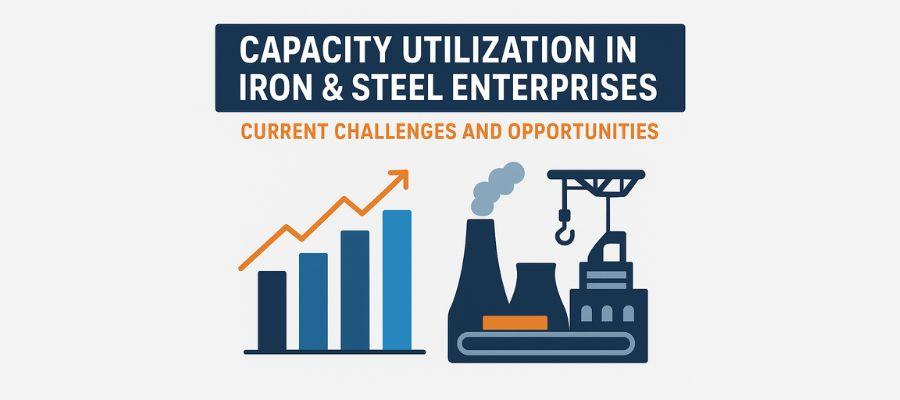The iron and steel industry is the backbone of modern industrial growth, playing a pivotal role in construction, infrastructure, automotive, and manufacturing sectors. Yet, one of the key indicators of its efficiency, capacity utilisation, has come under scrutiny in recent years. Capacity utilisation refers to the extent to which enterprises are using their installed production potential. For iron and steel enterprises, this measure reflects how effectively plants are balancing demand, supply, costs, and operational efficiency.
At present, global and regional steel enterprises are facing mixed trends in utilisation rates. While some economies are improving due to demand recovery, others continue to struggle with overcapacity, high energy costs, and fluctuating raw material availability.
The Current Situation
Globally, capacity utilisation in the steel industry averages around 75–78%, though this varies widely between countries. Mature markets such as the United States and Europe operate at relatively higher efficiency due to optimised production systems and stable demand. However, countries with rapid industrial growth, like India and China, often witness challenges of overcapacity, where installed capacity exceeds actual demand.
Enterprises that operate below 70% capacity utilisation often face issues of profitability, as fixed costs remain high while production volumes fail to optimise economies of scale. Conversely, plants running at above 85% capacity utilisation typically demonstrate better profitability, supply stability, and stronger competitiveness in global markets.
Key Challenges Facing Capacity Utilisation
- Overcapacity
The global steel industry has long battled with overcapacity, particularly in Asia. China, with its massive steel output, has created a surplus that often depresses global prices, leaving enterprises in other regions struggling with underutilised plants. - Volatile Demand
Steel demand fluctuates with cycles in construction, automotive, and infrastructure spending. Slowdowns in these sectors quickly reduce utilisation rates, creating supply-demand imbalances. - High Energy and Raw Material Costs
Iron ore, coal, and energy costs significantly impact utilisation. Enterprises with access to affordable energy and raw materials maintain higher utilisation, while others face shutdowns or reduced operations. - Environmental Regulations
Stricter emissions and sustainability norms often require partial shutdowns or production cuts. Enterprises lacking cleaner technologies face the dual challenge of compliance costs and reduced operational capacity. - Geopolitical Instability
Conflicts, trade restrictions, and disrupted supply chains further limit utilisation levels, particularly in export-driven economies.
Opportunities for Improving Utilisation
Despite these challenges, the steel industry has avenues to enhance its performance:
- Adoption of Green Technologies: Transitioning to energy-efficient methods like electric arc furnaces (EAFs) can improve efficiency and help meet regulatory standards.
- Capacity Rationalisation: Closing inefficient plants and consolidating operations enables enterprises to maintain optimal utilisation rates.
- Diversified Demand: Expanding applications in renewable energy infrastructure, electric vehicles, and urban development can stabilise demand.
- Government Support: Policy measures, incentives for modernisation, and infrastructure investments can create a steady demand pipeline.
Capacity Utilisation Snapshot by Region (2025 Estimates)
Region | Average Capacity Utilisation (%) | Key Insights |
North America | 80–82% | Stable demand, efficient operations |
Europe | 75–77% | Impacted by energy costs, regulatory pressures |
China | 73–75% | Overcapacity, government-led curtailments |
India | 77–79% | Strong demand growth, but raw material challenges |
Middle East | 70–72% | Infrastructure-driven demand, energy cost advantage |
Africa | 60–65% | Limited infrastructure, dependency on imports |
Future Outlook
The future of capacity utilisation in iron and steel enterprises depends heavily on how companies balance production with demand growth. Enterprises that invest in green technology, energy efficiency, and diversification will remain competitive, while those unable to modernise risk further underutilization.
With global demand for steel projected to grow steadily, driven by urbanisation, renewable energy projects, and manufacturing expansion, capacity utilisation levels are expected to improve gradually. However, the uneven distribution of demand and raw material access means regional disparities will persist.
Conclusion
Capacity utilisation in iron and steel enterprises remains both a challenge and an opportunity. On one hand, global overcapacity, high costs, and regulatory hurdles weigh down utilisation rates. On the other hand, rising demand for infrastructure and green technologies opens new possibilities. The enterprises that strategically adapt, innovate, and align with sustainable practices will be best positioned to maximise utilisation and profitability in the coming years.
For updates and additional information, follow on social media platforms.
Social Media: LinkedIn, Instagram, Facebook, Pinterest.

